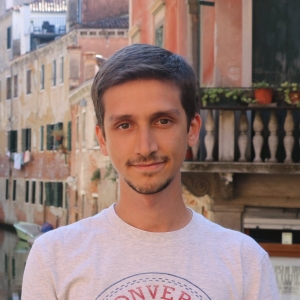Adel Kara Slimane
CEA
ZOOM LINK TO JOIN IN: http://s.ic.fo/QTD_Transport191020
Monday Oct 19, 2020 / 18:00-18:30 CEST
Simulating time-dependent thermoelectric transport in quantum systems
Adel KARA SLIMANE, Phillipp RECK, Geneviève FLEURY
Recent theoretical works suggest that the thermoelectric efficiency of a nano-device could be greatly enhanced1 if it is suddenly pushed out of equilibrium with the use of an external time-dependent parameter. Up to now, the literature is however dominated by theoretical studies using quantum dot models, most often solved with the non-equilibrium Green’s function (NEGF) approach2,3.
In the Group of Modeling and Theory at SPEC, CEA Saclay, we derived a theoretical framework4 for studying time-resolved thermoelectric transport and used it to implement an extension5 to the Python simulation library t-Kwant6,7 (developed at INAC, CEA Grenoble) to calculate time-dependent energy and heat currents as well as the density and input power. The library uses a wave function approach6,8,9, equivalent to the NEGF formalism but more efficient from a numerical standpoint, it enables simulating electronic – and now thermoelectric – transport in arbitrary (non-interacting) tight-binding models.
I will first introduce the theory behind t-Kwant and then discuss the (gauge-invariant) theoretical framework that we have built to describe time-dependent thermoelectric transport within t-Kwant. Then, I will show that we can reproduce with tKwant previous results derived in the literature for (single level) quantum dot models. Finally, I will discuss the possibility offered by t-Kwant of investigating dynamic thermoelectric transport in more complex nanodevices.
1 H. Zhou, J. Thingna, P. Hänggi, J.-S. Wang, and B. Li, Scientific Reports 5, 14870 (2015).
2 A. Crépieux, F. Šimkovic, B. Cambon, and F. Michelini, Phys. Rev. B 83, 153417 (2011), and Phys. Rev. B 89, 239907(E) (2014).
3 A.-M. Daré and P. Lombardo, Phys. Rev. B 93, 035303 (2016).
4 A. Kara Slimane, P. Reck, and G. Fleury, Phys. Rev. B 101, 235413 (2020)
5 Python module called ‘tkwantoperator’. It is free and open source, more information on https://kwant-project.org/extensions/tkwantoperator/
6 T. Kloss, J. Weston, B. Gaury, B. Rossignol, C. Groth, X. Waintal, https://arxiv.org/abs/2009.03132 (2020)
7 The t-Kwant Python package is a free and open-source, more information on https://kwant-project.org/extensions/tkwant/
8 B. Gaury, J. Weston, M. Santin, M. Houzet, C. Groth, and X. Waintal, Physics Reports 534, 1 (2014)
9 J. Weston and X. Waintal, Journal of Computational Electronics 15, 1148 (2016).

